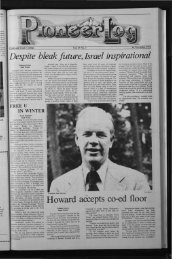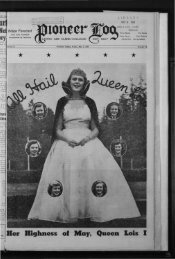Footprints of Pacifism - Lewis & Clark Digital Collections - Lewis ...
Footprints of Pacifism - Lewis & Clark Digital Collections - Lewis ...
Footprints of Pacifism - Lewis & Clark Digital Collections - Lewis ...
You also want an ePaper? Increase the reach of your titles
YUMPU automatically turns print PDFs into web optimized ePapers that Google loves.
Grundtvig Folk School on Eagle Creek in the Columbia Gorge, close to Cascade Locks. He died in 1981.<br />
Windsor Utley, in blue shirt and trousers, smoking a pipe, painted c. 1942 (see reproduction opposite). Born in<br />
1920 and trained in music at UCLA, Utley made a number <strong>of</strong> paintings at Cascade Locks. Utley committed himself<br />
full-time to art in 1947, painting mainly abstract impressionist inventions showing some kinship with those<br />
<strong>of</strong> his friend Mark Tobey. A teacher in Seattle, he died in 1989. His correspondence with Tobey is archived at the<br />
Smithsonian.<br />
Bill Webb (born 1919) is shown against the background <strong>of</strong> a framed female nude and socialist slogans. This painting<br />
was completed around 1948. Bill Webb contributed three items to the first (1943) issue <strong>of</strong> the journal edited<br />
by Sheets and Nomland, The Illiterati, which was confiscated by the postal service. He also designed the set for the<br />
satirical drama Stalingrad Stalemate in October 1942 and acted in the performance; he is seen lying on the bed in the<br />
production photographs (case 1). He left camp and entered prison in May 1943. After release, Webb worked as a<br />
textile designer and photographer.<br />
The watercolor <strong>of</strong> one <strong>of</strong> the Columbia Gorge waterfalls close to the CPS camp is signed “Kemper Nomland June<br />
1942.” See back cover <strong>of</strong> catalog.<br />
Mark Schrock, director <strong>of</strong> the Cascade Locks camp, is standing beside his portrait by Kemper Nomland. This oil<br />
painting, which hung in the camp library, was lost when the library burned.<br />
Kemper Nomland at Cascade Locks camp holding his portrait <strong>of</strong> Kermit Sheets. This oil painting’s whereabouts is<br />
currently unknown.<br />
Kemper Nomland’s essay “The Metaphysical in Graphic Art” was published in Illiterati 2, Cascade Locks, Summer<br />
1943. His ideas are captured by the following statement from the essay: “By branching into the realm <strong>of</strong> the abstract<br />
one can convey a whole new expanse <strong>of</strong> ideas that is impossible in realism. Also it is possible for a number <strong>of</strong> moods<br />
and ideas to be conveyed both simultaneously and consecutively.” Kemper’s experiments in abstraction are exemplified<br />
in the three later pieces: a design made for Illiterati 5 (1948) and the two pastels, “The Concert” (1992) and “Anti-<br />
War Rally 1969 Westlake Park” (1994), shown on the front cover.<br />
Also exhibited: passages from Tom Polk Miller’s memoir War’s End, Portland, which was inspired by events in Portland<br />
on the day <strong>of</strong> Kemper Nomland’s trial for refusal to obey a Selective Service order. A large part <strong>of</strong> his narrative was<br />
drawn upon by William Stafford for the penultimate chapter <strong>of</strong> his 1947 memoir Down in My Heart.<br />
8





